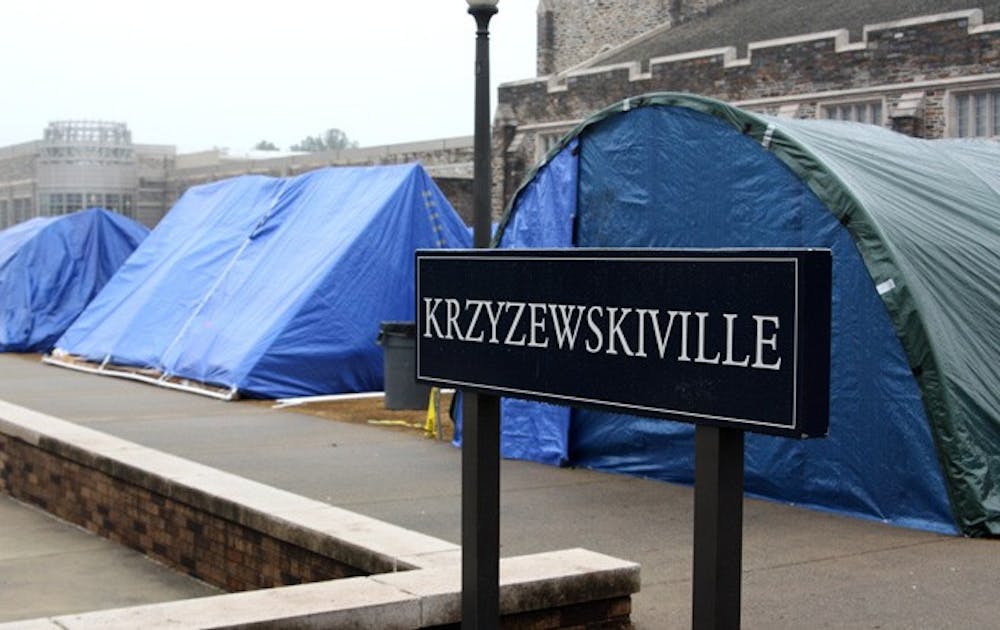Homemade tents in Krzyzewskiville faced a challenge out of concern for public safety.
The rules in K-ville outlaw the use of store-bought tents during the black tenting season—the first and most rigorous phase of the tenting process. To combat the cold winter weather, the students willing to sleep in K-ville created giant, student-made structures to live in. The Fire Safety Division of Duke’s Occupational and Environmental Safety Office, however, intervened earlier this month and ordered these tents to be taken down because of safety concerns.
If anything, some of the tents resembled army barracks and castles more so than they did tents, with some of the record-setting 46 black tents standing more than 10 feet tall. When the students began to create these monstrosities, they did so without too much consideration for rules and restrictions outside the purview of K-ville.
Eventually, somebody from the Fire Safety Division examined the structures and on Jan. 15, the fire marshal sent word out through the line monitors—the students who police Krzyzewskiville—that the structures had to be disassembled.
Read more about this year's matchup between Duke and North Carolina
“Some sort of fire marshal was not comfortable having structures that were man-made and not flame retardant,” said Grace Summers, a senior black tenter. “People were really mad at the line monitors, but it’s not like they could do anything.”
The main problem for the fire marshal stemmed from the use of flammable products in the structures. According to the Fire Safety Division, if these objects were to be contacted by melting membrane materials they would pose a serious danger to the students inside. These materials were found when one group used aluminum foil and wax paper for insulation of their structure.
Many of the ideas for structures were paid for and built within the first two days, which made the news on Jan. 15 all the more difficult to hear.
“On January 15, the office of fire and life safety notified Student Affairs that there were serious concerns about life safety issues and the possibility of even death because of the products that were being used in K-ville,” said Chris Roby, director of University Center Activities and Events.
Money was another issue when it came to the line monitors being forced to end the structures, as many groups had already purchased wood, PVC pipes and tarps totaling more than $300, with some spending even more than that.
“We spent somewhere between $200 and $300 on all the supplies. After the rain fiasco on that Monday we bought more PVC pipe to make an arch so it wouldn’t drip down,” Summers said. “We were planning on just keeping that, and that’s why we spent more money on it, so that was kind of a bummer.”
Although most structures were not taken to that extreme, several groups tested the limits of both the fire marshal and city. It would seem no matter how many engineering majors created some structures, they were not sound enough to pass code.
“The first night of black tenting, the people next to us built a house. They literally built a four-walled structure,” Summers said. “Turns out that’s not okay. If you have a building with four walls you have to register it with the city.”
Even though these student-made structures have since been dismantled, not all memorable structures were 10 feet tall or code-breaking in their designs. Some groups stuck to the very basics, needing only protection from the wind and rain rather than somewhere to socialize.
“I’ll give credit to the guys down on the far end, who for the first couple days just had a tarp on the bottom and a tarp over them,” said Zach Morrow, a freshman black tenter.
This type of creativity, while impressive, also creates a dangerous threat and liability for the University. The possibility of student harm in Krzyzewskiville was not a chance the University was willing to take, Roby said.
“When it comes to students’ life and safety, that really isn’t negotiable. We worked with the head line monitors to implement the change,” Roby said.
Although the head line monitors declined comment, it is believed that the practice of students constructing their own tents and structures will be prohibited, with students required to purchase commercial-made tents instead. “The recommendation was that to ensure the safety of students, they use tents that were purchased that have the specific specifications that are being safe and fire retardant,” Roby said.
While it took some time to come around, not all students are opposed to the new rules, at least not after they had a good night’s sleep in their new tent.
“We were sad to get rid of it, because we worked so hard, but once we got the real tent we were like, ‘Wow this is really nice. Why did we want to keep the old one?’” Summers said.
Get The Chronicle straight to your inbox
Signup for our weekly newsletter. Cancel at any time.

